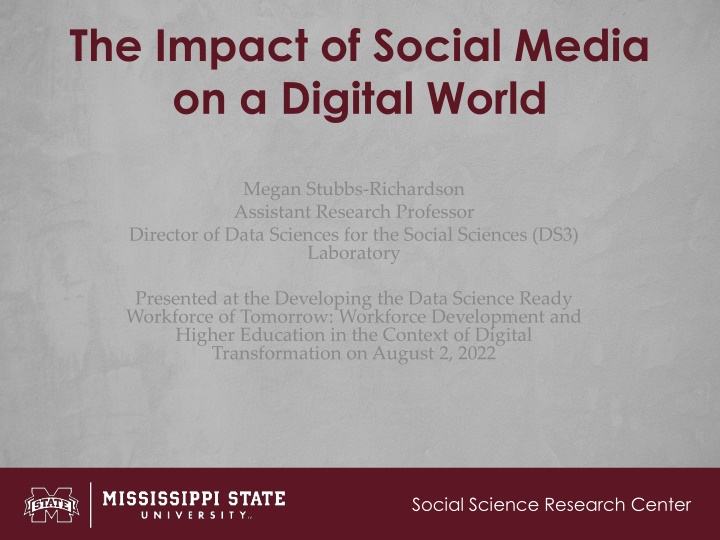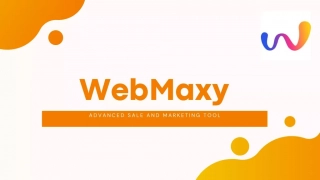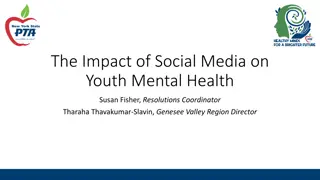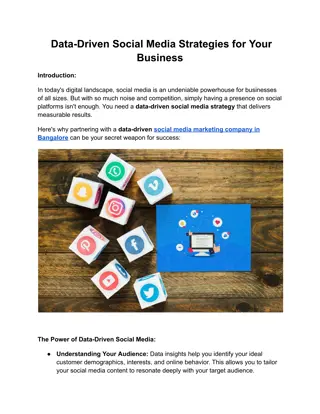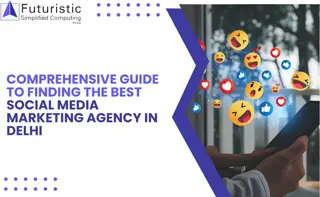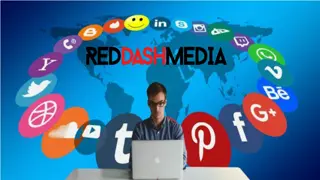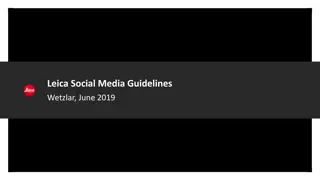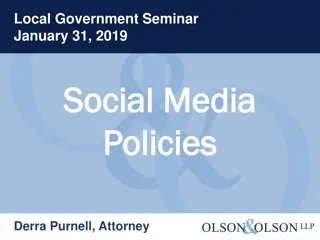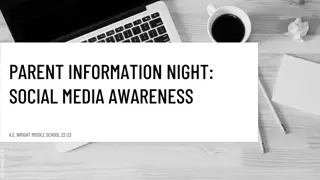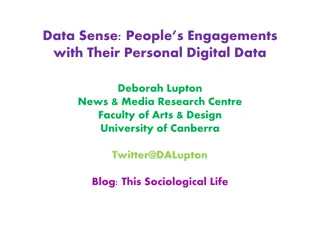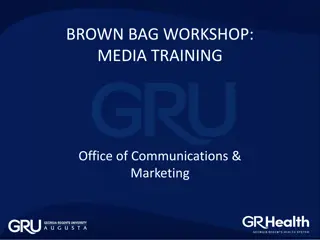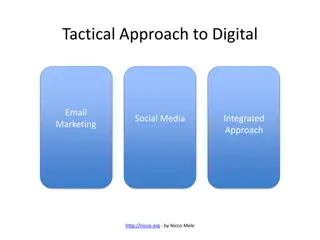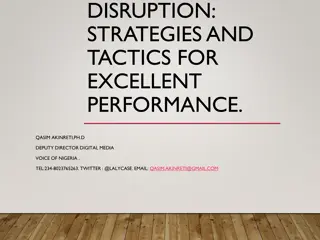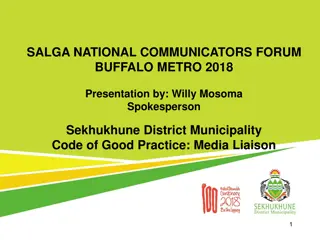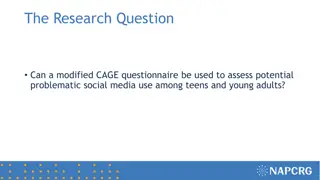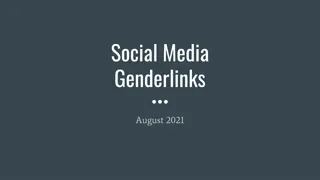The Impact of Social Media on a Digital World - Data Science Perspective
Exploring the influence of social media on a digital world through the lens of data science, focusing on the research conducted by Megan Stubbs-Richardson, an Assistant Research Professor. The need for a diverse data science workforce to interpret vast amounts of digital data from social media platforms is emphasized.
Download Presentation

Please find below an Image/Link to download the presentation.
The content on the website is provided AS IS for your information and personal use only. It may not be sold, licensed, or shared on other websites without obtaining consent from the author.If you encounter any issues during the download, it is possible that the publisher has removed the file from their server.
You are allowed to download the files provided on this website for personal or commercial use, subject to the condition that they are used lawfully. All files are the property of their respective owners.
The content on the website is provided AS IS for your information and personal use only. It may not be sold, licensed, or shared on other websites without obtaining consent from the author.
E N D
Presentation Transcript
The Impact of Social Media on a Digital World Megan Stubbs-Richardson Assistant Research Professor Director of Data Sciences for the Social Sciences (DS3) Laboratory Presented at the Developing the Data Science Ready Workforce of Tomorrow: Workforce Development and Higher Education in the Context of Digital Transformation on August 2, 2022 Social Science Research Center
Background Social Scientist interested in Data Science Conducted research on digital media data since 2012: beginning with Twitter data Open-source intelligence research using Babel Street (60 + platforms with language translation capabilities) NSF Rapid project (2020 current) - collecting data through Application Programming Interfaces (APIs) for 10 platforms Applied a variety of methodological approaches to digital data over time Social Science Research Center
Background Director of Data Science for the Social Sciences Laboratory About us: https://ds3.ssrc.msstate.edu/ Interdisciplinary collaborative Faculty, Staff, Students Meet bi-weekly to work on projects Analyzing Covid-19 content across 10 social media and forums platforms Examining attitudes toward law enforcement using sentiment analyses Analyzing various aspects of the MeToo movement Social Science Research Center
The Need for a Data Science Workforce There exists a need for teams of professionals with a variety of skills at various levels There is a need to move away from the overloading of the term data scientist toward teams of data science professionals (Saltz & Grady, 2017). Big data systems: data provider - > data collectors: prepare, analyze, visualize, management, security and privacy, to providing access to data consumers (Saltz & Grady, 2017). Social Science Research Center
The Need for a Data Science Workforce in Digital Data Vast amount of data with social media posts and forums often being qualitative in nature Need humans to interpret the meaning that machines often miss Various interdisciplinary levels of skills are needed Social Science Research Center
The Need for Examining Digital Data 89% of United States (U.S.) adults reported using the Internet (Pew Research Center 2018). U.S. Internet users tended to be college educated, between the ages of 18 and 49 and had an annual income over $30,000. Individuals in urban and suburban areas were more likely to be Internet users (Pew Research Center 2018). U.S. rates of Internet usage are similar for White, Black, and Hispanic men and women (Pew Research Center 2018). However, demographics vary widely when it comes to social media usage (Auxier & Anderson, 2021). Social Science Research Center
The Need for Examining Digital Data Search engine optimization and increased Internet access has led to the pervasiveness of online searches for information acquisition. According to Purcell et al. (2012), 91% of all online adults use search engines. Of those using search engines, roughly 83% rely on Google (Purcell et al. 2012). Social Science Research Center
The Need for Examining Digital Data Social media use has increased faster than pre-pandemic, with a reach globally of almost 13 new users every second (Datareportal, 2022; Kepios, 2022). There are 4.70 billion active social media users world-wide (Datareportal, 2022; Kepios, 2022). Internet users aged 16 to 64 spend 2 hours and 27 minutes on social media on average per day (Datareportal, 2022; Kepios, 2022). Social Science Research Center
The Need for Examining Digital Data The top five reasons reported for using the Internet (Datareportal, 2022; Kepios, 2022): Finding information Staying in touch with friends and family Keeping up to date with news and events Watching videos, TV shows, and movies Researching how to do things Social Science Research Center
The Need for Examining Digital Data U.S. Social Media use: 81% of U.S. adults use YouTube, 69% use Facebook, 40% use Instagram, 31% use Pinterest, 28% use Linkedin, 25% use Snapchat, 23% use Twitter, 23% use WhatsApp, 21% use TikTok, 18% use Reddit, and 13% use Nextdoor (Anderson & Jiang, 2018). 85% of U.S. teens aged 13-17 use YouTube, 72% use Instagram, 69% use Snapchat, 51% use Facebook, 32% use Twitter, 9% use Tumblr, and 7% use Reddit (Auxier & Anderson, 2021). Social Science Research Center
The Need for Examining Digital Data Interpersonal communication is not an isolated action. It is impacted by the type of platform used, the information exchanged, what communication occurs, and how it is shared. Social media has changed the nature of our relationships and social institutions (Butler & Matook, 2015): Family, friends, co-workers, classmates, strangers Family, Work, Education, Healthcare, etc. Social Science Research Center
The Need for Examining Digital Data Overcomes barriers of former relationship development (e.g., proximity) New relationships bridge geographic, political, and social boundaries and are a significant driver of social media s transformative impact on organizations and society (Butler & Matook, 2015). Just like offline, there is an array of prosocial and antisocial behavior online. Social Science Research Center
The Need for Examining Digital Data Prosocial Behavior behavior with the intention of benefiting other people Helping (e.g., providing support to victims) Sharing Donating (e.g., GoFundMe) Co-operating Volunteering (e.g., Hurricane Sandy) Social Science Research Center
The Need for Examining Digital Data Antisocial Behavior disruptive acts by covert or overt hostility or aggression towards others (and sometimes property of others) Cyberbullying, victim blaming, hate speech Computer crimes (e.g., theft) Stalking Organized crime (e.g., terrorism) Illicit supply networks Social Science Research Center
The Need for Examining Digital Data In addition to our connection to people, our connection to technology is also changing: The Internet enables social technology for knowledge consumption and production (Hartley, 2011). Increased internet access, Google, YouTube, Siri: Access to new skills/learning resources, DIY projects, recipes, Smart phones, tablets have increased Internet access Social Science Research Center
The Need for Examining Digital Data We can quickly access new information and learn quite a bit online. With YouTube in mind the internet has rapidly evolved into a new enabling social technology for knowledge (Dezuanni, 2021; Hartley, 2011). But this access to knowledge is not without misinformation (Wong et al., 2021). Rush to publish new content Anyone can post new content No peer review process Social Science Research Center
The Need for Examining Digital Data All of this human behavior and human to machine interaction is DIGITAL! There are tools to collect it! There are tools to analyze it! And, we need TEAMS of people with various skills to analyze the VAST amount of data! Social Science Research Center
The Need for Examining Digital Data The skills needed in data science involve making sense of vast amounts of largely qualitative data (i.e., content of posts). Literature Reviews Developing codebooks Automated computational coding Hand labeling data for training machine learning models Flagging illicit content to report to law enforcement or other agencies Social Science Research Center
The Need for Examining Digital Data The Scientific Method The Technical Aspects Research Studies as examples Social Science Research Center
How should I begin conducting research online? The Science Side: The Scientific Method Select a topic of interest Identify a research question Conduct a literature review Refine your research question Conceptualization and operationalization of variables Study design: Quantitative/Qualitative Develop a research codebook Code the data using the codebook and calculate inter-rater reliability to assess agreement Social Science Research Center
How should I begin conducting research online? The Technical Side: Data collection Three options: Application Programming Interface Web scraping Manual searches using single terms or phrases at a time Social Science Research Center
Example projects and research questions Rape Culture Project How is rape culture perpetuated on Twitter? Are victim blame/support tweets more influential? Google Property Crime Project Are crime prevention queries correlated with crime and crime reduction at the state level? Islamic State (IS) Magazines Project* How are IS magazines discussed online? Which platforms host the content the most? Social Science Research Center
Tweeting rape culture study Methods: Twitter data collected through the Social Media Tracking and Analysis System (SMTAS); Content Analysis; Analysis of Meta- data Results: Three themes were found: 1) Pro-victim - rape myth debunking, 2) Victim blame rape myth supporting, and 3) sharing news about sexual assault cases. Victim blaming tweets were more influential than victim supporting tweets (Stubbs-Richardson, Rader, & Cosby, 2018). Social Science Research Center
Searching for safety study Methods: Google Correlate Data; Uniform Crime Report Data; Aggregated search terms related to crime prevention; ANOVA Results: Moderate to strong correlates between property crime and crime prevention search terms 86% of the correlations were significant; 58% were significantly correlated with crime reduction Strongest keyword searches were for the surveillance category (e.g., home/car alarm systems; Stubbs- Richardson, Cosby, Bergene, & Cosby, 2018). Social Science Research Center
Islamic State propaganda study Methods: Babel Street data (27 relevant sources, language translation 100 + languages); Content analysis (yes or no); Automated coding procedures; filtering out and reporting illicit content to authorities Results: While most sources were news related (53%) or for academic purposes (28%), 6% were intended to recruit for the Islamic State (IS) while 2% of posts bragged about IS accomplishments to opposing audiences; Stubbs-Richardson et al., 2020). Top three places: Blogs (32%), Facebook (18%), and LinkedIn (18%) with other stats ranging from 0.2 to 6.9% for other platforms. Social Science Research Center
NSF Rapid Project Covid-19 Online Prevalence of Emotions in Institutions Database (Richardson, Anreddy, & Porter, 2020). For information about the COPE-ID Database: https://copeid.ssrc.msstate.edu/ Data sources: Twitter, Gab, Tumblr, Flickr, 4chan, 8kun, Mastodon, Parler, Reddit, and YouTube. Social Science Research Center
NSF Rapid Project Keywords: Covid-19; sars-cov-2, corona, corona virus, coronavirus, coronaviruses, social distancing, quarantine, covid19, pandemic, virus, #socialdistancing Dates: January 2020 April 2021 Research Areas: Misinformation and counter misinformation* Machine learning models of misinformation across platforms Emotion detection Emotions linked to health prevention regulations Social Science Research Center
Importance of developing a codebook Developing a codebook to make sense of a variety of posts Literature reviews Qualitative analyses of the data Creating definitions for variables of interest Establishing exclusion and inclusion criteria Meeting regularly to discuss codes Refining the codebook Following the links for full contextual clues prior to labeling the data Social Science Research Center
Example codebook G_MISINFO (General Misinformation on COVID-19) is false or inaccurate information that is deliberately created and is intentionally or unintentionally propagated on COVID-19. For example, the document may use hashtags such as #CovidHoax, #Plandemic, #FauciFraud, and #DePopulation. *As connected to the #Depopulation hashtags, such arguments falling in this category believe for example that Bill Gates created Covid in a secret lab. Some also believe he created the vaccine for depopulation which would fall under the vaccine misinformation category. *Note, a post can include both general misinformation and vaccine misinformation. It can be classified as both categories (1 = yes) when the definitions apply in both cases. Is the document about GENERAL COVID-19 MISINFORMATION? 1 = YES, 2 = MAYBE, 3 = NO Social Science Research Center
Example codebook GC_MISINFO (General Counter of Misinformation on COVID-19) is generally countering misinformation by offering facts or sharing personal experiences in attempt to correct misinformation related to COVID-19. Note, true factual statements are not enough to classify the document as countering general misinformation. The post must clearly seem to be intended for that purpose, such as replying to another person to correct misinformation. Is the document about COUNTERING GENERAL COVID- 19 MISINFORMATION? 1 = YES, 2 = MAYBE, 3 = NO Social Science Research Center
Example codebook V_MISINFO (Misinformation on COVID-19 vaccines) is false or inaccurate information that is deliberately created and is intentionally or unintentionally propagated about the COVID-19 vaccine. *If you see the hashtag, #nocovidvaccine but the document has no additional text/hashtags to indicate why they do not want the vaccine, this is not enough information to code it as misinformation. *If the hashtag, #nocovidvaccine is connected to depopulation/ population control or #Depopulation #PopulationControl type arguments/hashtags, then it can be coded as vaccine misinformation. The depopulation argument is misinformation that has been flagged by agencies and is tied to both Covid-19 generally and the Covid-19 vaccine. For example, some believe it is Bill Gates plan to depopulate the world through forced vaccination. *Note, a post can include both general misinformation and vaccine misinformation. It can be classified as both categories (1 = yes) when the definitions apply in both cases. Is the document about VACCINE MISINFORMATION? 1 = YES, 2 = MAYBE, 3 = NO Social Science Research Center
Example codebook VC_MISINFO (Vaccine Counter of Misinformation on COVID- 19 vaccine) is countering specific misinformation by offering facts or sharing personal experiences in attempt to correct misinformation related to COVID-19 vaccines. * Note, true factual statements are not enough to classify the document as countering vaccine related misinformation. The post must clearly seem to be intended for that purpose, such as replying to another person to correct misinformation surrounding the vaccine or sharing one s personal experience with the vaccine in a way that seems intended to reduce more widespread fear or misinformation connected to vaccination. Is the document about a COUNTERING COVID-19 VACCINE MISINFORMATION? 1 = YES, 2 = MAYBE, 3 = NO Social Science Research Center
Example codebook G_CYBERCRIME (General Cybercrime related to COVID- 19) is the larger category that includes the subcategories: SCAMS and FRAUD. This could come from the perspective of offenders, victims, or society and for instance may include warnings about scams related to COVID-19. Is the document about GENERAL COVID-19 CYBERCRIME? 1 = YES, 2 = MAYBE, 3 = NO *Cybercrime includes SCAM and or FRAUD. To be labeled CYBERCRIME, the code must either fit the SCAM or FRAUD definitions below. Social Science Research Center
Example codebook V_CYBERCRIME (Cybercrime related to COVID-19 vaccines) is the larger category that includes the subcategories: SCAMS and FRAUD. This could come from the perspective of offenders, victims, or society and for instance may include warnings about scams related to vaccines. Is the document about COVID-19 VACCINE CYBERCRIME? 1 = YES, 2 = MAYBE, 3 = NO SCAMS usually include an attempt to manipulate or mislead another person for financial gain. For example, this may entail offering something false (e.g., fake vaccines, fake cures of COVID-19) or lead to fake government websites. FRAUD occurs when individuals or organizations claim untrue elements about an event or topic (e.g., COVID-19 vaccinations) that is believed by victims who act upon the false information and usually suffers the loss of money or property as a result. Social Science Research Center
Analyses of Digital Data Once you have classified the posts, you can conduct a variety of analyses of the data: Inter-rater reliability Qualitative and Quantitative analysis Analyses of Meta-Data Data of the Data - @ mentions, re- posts/shares to assess influence/spread of the content Content analysis Spatial analysis Network analysis Automated coding Machine learning Topic modeling Social Science Research Center
References Anderson, M., & Jiang, J. (2018, November 28). Teens Social Media Habits and Experiences. Pew Research Center: Internet, Science & Tech. Auxier, B., & Anderson, M. (2021, April 7). Social Media Use in 2021. Pew Research Center: Internet, Science & Tech. https://www.pewresearch.org/internet/2021/04/07/social-media- use-in-2021/ Butler, B. S., & Matook, S. (2015). Social media and relationships. The international encyclopedia of digital communication and society, 1-12. Datareportal. (2022). Digital 2022 July Global Statshot Report. https://datareportal.com/global-digital-overview Social Science Research Center
References Dezuanni, M. L. (2021). TIKTOK S PEER PEDAGOGIES - LEARNING ABOUT BOOKS THROUGH #BOOKTOK VIDEOS. AoIR Selected Papers of Internet Research. https://doi.org/10.5210/spir.v2021i0.11901 Hartley, J. (2011). The Uses of Digital Literacy (Vol. 40). SAGE Publications Inc. https://doi.org/10.1177/0094306110396849e Kepios. (2022). Digital 2022 Global Overview Report: The Essential Guide To The World s Connected Behaviors. https://kepios.com/reports Social Science Research Center
References Pew Research Center. (2018, February 5). Internet/Broadband Fact Sheet. Retrieved from http://www.pewin terne t.org/fact- sheet /inter net-broadband/#. Accessed August 1, 2022. Purcell, K., Brenner, J., & Rainie, L. (2012, March 9). Search engine use 2012. Retrieved from http://www.pewin terne t.org/2012/03/09/searc h-engine-use-2012/. Accessed August 1, 2022. Richardson, M., Anreddy, S. R., & Porter, B. (2020)., RAPID: Analyses of Emotions Expressed in Social Media and Forums During the COVID-19 Pandemic, National Science Foundation, Award Abstract #2031246, https://www.nsf.gov/awardsearch/ Social Science Research Center
References Saltz, J. S., & Grady, N. W. (2017, December). The ambiguity of data science team roles and the need for a data science workforce framework. In 2017 IEEE international conference on big data (Big Data) (pp. 2355-2361). IEEE. Stubbs-Richardson, M. S., Cosby, A. K., Bergene, K. D., & Cosby, A. G. (2018). Searching for safety: crime prevention in the era of Google. Crime Science, 7(1), 1-13. Stubbs-Richardson, M., Hubbert, J., Nelson, S., Reid, A., Johnson, T., Young, G., & Hopkins, A. (2020). Not Your Typical Social Media Influencer: Exploring the Who, What, and Where of Islamic State Online Propaganda. International Journal of Cyber Criminology, 14(2), 479-496. Social Science Research Center
References Stubbs-Richardson, M., Rader, N. E., & Cosby, A. G. (2018). Tweeting rape culture: Examining portrayals of victim blaming in discussions of sexual assault cases on Twitter. Feminism & Psychology, 28(1), 90-108. Wong, A., Ho, S., Olusanya, O., Antonini, M. V., & Lyness, D. (2021). The use of social media and online communications in times of pandemic COVID-19. Journal of the Intensive Care Society, 22(3), 255 260. https://doi.org/10.1177/1751143720966280 Social Science Research Center
Questions? Megan Stubbs-Richardson megan@ssrc.msstate.edu Social Science Research Center
